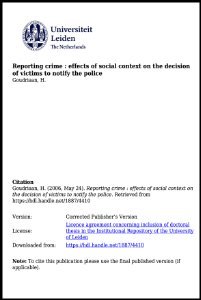By Samuel Langton, Tim Verlaan, Stijn Ruiter
Analyses of emergency calls for service data in the United States suggest that around 50% of dispatched police deployment time is spent on crime-related incidents. The remainder of time is spent in a social service capacity: attending well-being checks and resolving disturbances, for instance. These findings have made a considerable contribution to the discourse around public perceptions of the police and the distribution of public funds towards (or away) from law enforcement. Yet, an outstanding issue remains. No investigation has been undertaken into whether findings are robust to the different ways in which ‘time spent’ is operationalized in these studies. Using dispatch data for Amsterdam during 2019, this study compares three operationalizations of ‘time spent’. Additionally, in order to provide some context on the potential mechanisms through which these different operationalizations might yield different results, we report on dispatch numbers per incident category and provide an initial exploration into ‘multi-dispatch’ incident types. We find that general proportional breakdowns are fairly robust to the time measure used. However, for some incident categories (e.g. Health) and incident types (e.g. Shootings), analyzed in isolation, the results are not robust to the different operationalizations. We propose that the mechanism explaining this lack of robustness can be traced to the high dispatch numbers for specific incident categories and types, particularly those with an imminent threat to life.
Crime Science volume 12, Article number: 20 (2023)










